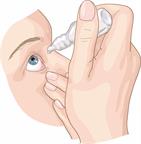Eye Infection (Bacterial Conjunctivitis) in Children: What to Know
Bacterial conjunctivitis is an infection and swelling of the clear membrane that covers the white part of the eye and the inner part of the eyelid (conjunctiva).
This infection can make your child's eye:
Red or pink.
Itchy or irritated.
Depending on the type of germ (bacteria), this infection can be contagious, which means it spreads easily from person to person. It can also spread from one eye to the other eye.
What are the causes?
This condition is caused by germs. Your child may get the infection if they have close contact with:
A person who has the infection.
Things that have germs on them (are contaminated), such as towels, pillow cases, contact lens solution, or eye makeup.
What increases the risk?
The following factors may make your child more likely to develop this condition:
Having contact with people who have the infection.
Wearing contact lenses.
Having a sinus infection.
Having had a recent eye injury or surgery.
Having a weak body defense system (immune system).
Having dry eyes.
What are the signs or symptoms?

Symptoms include:
Thick, yellow discharge or pus coming from the eye or eyes.
Pink or red eye or eyes.
Sore or painful eyes, or a burning feeling in the eyes.
Eyelids that stick together because of the pus or crusts.
Tearing or watery eyes.
Itchy eyes.
Swollen eyelids.
Other symptoms may include:
How is this diagnosed?
This condition is diagnosed based on:
Your child's symptoms and medical history.
An exam of your child's eye.
Testing a sample of discharge or pus from your child's eye. This is rarely done.
How is this treated?

This condition may be treated by:
Follow these instructions at home:
Medicines
-
Give your child medicines only as told.
-
If your child was given antibiotics, give the antibiotics as told. Do not stop giving the antibiotics even if your child starts to feel better, unless told by your child's provider.
-
Do not touch the edge of the affected eyelid with the eye drop bottle or ointment tube when putting medicines to your child's eye. This will prevent the spread of infection to the other eye or to other people.
-
Do not give your child aspirin. It can make your child very sick.
Managing discomfort
Preventing the infection from spreading
-
Do not let your child share towels, pillowcases, or washcloths.
-
Do not let your child share eye makeup, makeup brushes, contact lenses, or glasses.
-
Have your child wash their hands often with soap and water for at least 20 seconds, especially before touching their face or eyes. Have your child use paper towels to dry their hands. If your child can't use soap and water, have your child use hand sanitizer.
-
Have your child avoid contact with other children while your child has symptoms, or as long as told by your child's health care provider.
General instructions
- If you child wears contact lenses, do not let your child wear them until the inflammation is gone and your child's provider says it is safe to wear them again.
-
Do not let your child wear eye makeup until the inflammation is gone. Throw away any old eye makeup.
-
Change or wash your child's pillowcase every day.
-
Have your child avoid touching or rubbing their eyes.
-
Do not let your child use a swimming pool while they still have symptoms.
Contact a health care provider if:
-
Your child has a fever.
-
Your child's symptoms get worse or do not get better with treatment.
-
Your child's symptoms do not get better after 10 days.
-
Your child's vision becomes suddenly blurry.
Contact your child's provider right away if:
Your baby is younger than 3 months old and has a temperature of 100.4°F (38°C) or higher.
Your child is 3 months old or older and has a temperature of 102.2°F (39°C) or higher.
Your child has a fever, and they look or act sick in a way that worries you.
If you can't reach the provider, go to an urgent care or emergency room.
-
Your child can't see.
-
Your child has very bad pain in the eyes.
-
Your child has facial pain, redness, or swelling.
These symptoms may be an emergency. Do not wait to see if the symptoms will go away. Call 911 right away.
This information is not intended to replace advice given to you by your health care provider. Make sure you discuss any questions you have with your health care provider.
 Symptoms include:
Symptoms include: This condition may be treated by:
This condition may be treated by: